Factors Influencing the Intrinsic Seismic Risk of Open Spaces in Existing Built Environments: A Systematic Review
Abstract
1. Introduction
1.1. Towards a Seismic Risk Assessment of Open Spaces
1.2. Research Approach and Work Aims
- Accomplishing a critical state-of-the-art based on a comprehensive literature review and organized by major themes deducted from the analyzed papers;
- Identifying factors influencing seismic risk in the OSs, both for LSs and ASs;
- Providing a first systematization of the risk factors identified, with the aim of a holistic characterization of seismic risk in urban OSs;
- Proposing, in this perspective, the organization of these factors in main categories to move toward a preliminary, quick, and literature-based risk index for the OS.
2. Phases and Methods of the Systematic and Bibliographic Review
2.1. Documents Identification: Search Strategy
2.2. Documents Screening: Inclusion Criteria
2.3. Documents Inclusion: Identification and Classification of the Final Studies Selected for the Review
2.4. Bibliometric Description and Classification of Documents
2.5. Collection and Analysis of the Risk Factors
3. Results
3.1. Descriptive and Bibliometric Analysis of Documents Involved in the Review Process
3.2. Analysis of the Final Selected Documents and the Synthesis of the Results
- Morpho-typological characteristics (Section 3.2.1): morpho-typology of the space, dimensions of the OS, number of lanes of LS;
- Physical characteristics (Section 3.2.2): quote difference of the OS, slope of the OS, slope near the OS, fixed obstacles, temporary obstacles;
- Constructive characteristics (Section 3.2.3): paving type, paving conditions;
- Characteristics of use and users (Section 3.2.4): presence of parked vehicles, accessibility for vehicles/pedestrians, types of users, density of users, preparedness of users;
- Characteristics of context (Section 3.2.5): seismicity, multi-hazard potential, ground type, lifeline utilities, urban OSs network, underground cavities.
3.2.1. Morpho-Typological Characteristics
3.2.2. Physical Characteristics
3.2.3. Constructive Characteristics
3.2.4. Characteristics of Use and Users
3.2.5. Characteristics of Context
4. Discussion
5. Conclusions
Supplementary Materials
Author Contributions
Funding
Institutional Review Board Statement
Informed Consent Statement
Data Availability Statement
Conflicts of Interest
Appendix A
| Cit | Authors | Category 1 | Category 2 | Category 3 | Category 4 | Category 5 | ||||||||||||||||
| Morpho-Typological Characteristics | Physical Characteristics | Constructive Characteristics | Characteristics of Uses and Users | Characteristics of Context | ||||||||||||||||||
| Morpho-Typology | Dimension of OS | Number of Lanes of LS | Quote Difference of OS | Slope of the OS | Slope Near the OS | Fixed Obstacles | Temporary Obstacles | Paving Type | Paving Condition | Parked Vehicles | Accessibility for Vehicles/Pedestrians | Types of Users | Density of Users | Preparedness of Users | Seismicity | Multi-Hazard Potential | Ground Type | Lifeline Utilities | Urban OSs Network | Underground Cavities | ||
| [38] | Adafer and Bensaibi (2015) | X | X | X | X | X | X | X | ||||||||||||||
| [39] | Álvarez et al. (2018) | X | X | X | X | X | X | |||||||||||||||
| [40] | Battegazzorre et al. (2021) | X | X | X | ||||||||||||||||||
| [23] | Bernabei et al. (2021) | X | X | X | X | |||||||||||||||||
| [41] | Bernardini and Ferreira (2020) | X | X | X | ||||||||||||||||||
| [42] | Cremonini (2004) | X | X | X | X | X | X | X | X | X | X | X | ||||||||||
| [9] | D’Andrea and Condorelli (2006) | X | X | X | X | X | ||||||||||||||||
| [43] | Der Sarkissian et al. (2020) | X | X | |||||||||||||||||||
| [44] | Ertugay et al. (2016) | X | ||||||||||||||||||||
| [45] | Fazzio (2004) | X | X | X | X | X | X | X | ||||||||||||||
| [46] | Giuliani et al. (2020) | X | X | X | X | X | X | X | X | |||||||||||||
| [47] | Goretti and Sarli (2006) | X | X | X | ||||||||||||||||||
| [48] | Hajibabaee et al. (2014) | X | X | X | X | X | X | X | X | |||||||||||||
| [49] | Ito et al. 2021 | X | X | X | X | |||||||||||||||||
| [50] | Kanno et al. (2016) | X | X | X | X | |||||||||||||||||
| [51] | Kheliouen, Bouder (2020) | X | X | |||||||||||||||||||
| [52] | Kumagai and Hatao (2013) | X | X | X | ||||||||||||||||||
| [53] | Lancioni et al. (2014) | X | X | X | ||||||||||||||||||
| [54] | León and March (2014) | X | X | X | X | X | X | X | X | X | ||||||||||||
| [55] | León et al. (2019) | X | X | X | X | X | X | X | X | X | X | X | ||||||||||
| [24] | Lo et al. (2020) | X | X | X | X | |||||||||||||||||
| [29] | Quagliarini et al. (2018) | X | X | X | X | X | X | X | X | X | X | X | X | X | X | X | X | |||||
| [22] | Santarelli et al. (2018) | X | X | X | X | |||||||||||||||||
| [56] | Sasabe et al. (2020) | X | X | X | X | |||||||||||||||||
| [57] | Tsionas et al. (2016) | X | X | X | ||||||||||||||||||
| [12] | Tumini et al. (2017) | X | X | X | X | X | X | |||||||||||||||
| [58] | Utami and Nurhadi (2018) | X | X | X | X | |||||||||||||||||
| [59] | Wang and Jia (2021) | X | X | X | X | X | X | |||||||||||||||
| [60] | Wood et al. (2016) | X | X | X | X | X | X | |||||||||||||||
| [61] | Yao et al. (2021) | X | X | X | X | X | X | |||||||||||||||
| [62] | Zhang et al. (2015) | X | X | X | X | X | X | |||||||||||||||
| [63] | Zlateski et al. (2020) | X | X | X | X | X | X | |||||||||||||||
References
- Haigh, R.; Amaratunga, D. An integrative review of the built environment discipline’s role in the development of society’s resilience to disasters. Int. J. Disaster Resil. Built Environ. 2010, 1, 11–24. [Google Scholar] [CrossRef]
- Quagliarini, E.; Currà, E.; Fatiguso, F.; Mochi, G.; Salvalai, G. Resilient and User-Centered Solutions for a Safer Built Environment against Sudden and Slow Onset Disasters: The BE S2ECURe Project. In Sustainability in Energy and Buildings 2020. Smart Innovation, Systems and Technologies; Littlewood, J., Howlett, R.J., Jain, L.C., Eds.; Springer: Singapore, 2021; Volume 203. [Google Scholar]
- Pereira, L.V. Urban Form Definition in Urban Planning; LNEC: Lisbon, Portugal, 1982. [Google Scholar]
- Russo, M.; Angelosanti, M.; Bernardini, G.; Cantatore, E.; D’Amico, A.; Currà, E.; Fatiguso, F.; Mochi, G.; Quagliarini, E. Morphological Systems of Open Spaces in Built Environment Prone to Sudden-Onset Disasters. In Sustainability in Energy and Buildings 2020 (Part of the Smart Innovation, Systems and Technologies Book Series—SIST, Volume 203—ISSN: 2190–3018); Littlewood, J., Howlett, R.J., Jain, L.C., Eds.; Springer: Singapore, 2021; pp. 321–331. ISBN 978-981-15-8783-2. [Google Scholar]
- Strappa, G. L’architettura Come Processo; Franco Angeli: Milan, Italy, 2014. [Google Scholar]
- Currà, E.; D’Amico, A.; Nettekoven, M. Seismic vulnerability and urban morphology, tools for urban and building integration. In City as Organism New Visions for Urban Life; Strappa, G., Amato, A.R.D., Camporeale, A., Eds.; U+D Edition: Roma, Italy, 2016; Volume 1, pp. 473–484. ISBN 978-88-941188-1-0. [Google Scholar]
- Allan, P.; Bryant, M.; Wirsching, C.; Garcia, D.; Teresa Rodriguez, M. The Influence of Urban Morphology on the Resilience of Cities Following an Earthquake. J. Urban Des. 2013, 18, 242–262. [Google Scholar] [CrossRef]
- Koren, D.; Rus, K. The potential of open space for enhancing urban seismic resilience: A literature review. Sustainability 2019, 11, 5942. [Google Scholar] [CrossRef]
- D’Andrea, A.; Condorelli, A. Metodologie e procedure per la valutazione del rischio sismico sulle infrastrutture varie. In Proceedings of the XXV Convegno Nazionale Stradale, Napoli, Italy, 4–7 October 2006; pp. 78–91. [Google Scholar]
- Costa, C.; Figueiredo, R.; Silva, V.; Bazzurro, P. Application of open tools and datasets to probabilistic modeling of road traffic disruptions due to earthquake damage. Earthq. Eng. Struct. Dyn. 2020, 49, 1236–1255. [Google Scholar] [CrossRef]
- Cutter, S.L. Vulnerability to environmental hazards. Prog. Hum. Geogr. 1996, 20, 529–539. [Google Scholar] [CrossRef]
- Tumini, I.; Villagra-Islas, P.; Herrmann-Lunecke, G. Evaluating reconstruction effects on urban resilience: A comparison between two Chilean tsunami-prone cities. Nat. Hazards 2017, 85, 1363–1392. [Google Scholar] [CrossRef]
- Angelosanti, M.; Bernabei, L.; Russo, M.; D’Amico, A.; Bernardini, G.; Cantatore, E.; Fatiguso, F.; Salvalai, G.; Mochi, G.; Quagliarini, E.; et al. Towards a multi-risk assessment of Open Spaces and its users: A rapid survey form to collect and manage risk factors. In Sustainability in Energy and Buildings 2021 (Part of the Smart Innovation, Systems and Technologies Book Series—SIST, Volume 263—ISSN: 2190–3018); Littlewood, J., Howlett, R.J., Jain, L.C., Eds.; Springer: Singapore, 2021; pp. 209–218. ISBN 978-981-16-6269-0. [Google Scholar]
- D’Amico, A.; Russo, M.; Bernabei, L.; Angelosanti, M.; Cantatore, E.; Bernardini, G.; Fatiguso, F.; Salvalai, G.; Mochi, G.; Quagliarini, E.; et al. Verso una valutazione multi-rischio per la sicurezza dell’ambiente costruito e dei suoi utenti: Una scheda per la definizione di scenari negli spazi aperti urbani. In Proceedings of the Design and Construction Tradition and Innovation in the Practice of Architecture Progetto—Colloqui.AT.e; Sicignano, E., Ed.; EdicomEdizioni Monfalcone (Gorizia): Salerno, Italy, 2021; pp. 1508–1525. [Google Scholar]
- Centre for Research on the Epidemiology of Disasters (CRED) EM-DAT Database. Available online: https://public.emdat.be/ (accessed on 18 October 2021).
- Shrestha, S.R.; Sliuzas, R.; Kuffer, M. Open spaces and risk perception in post-earthquake Kathmandu city. Appl. Geogr. 2018, 93, 81–91. [Google Scholar] [CrossRef]
- French, E.L.; Birchall, S.J.; Landman, K.; Brown, R.D. Designing public open space to support seismic resilience: A systematic review. Int. J. Disaster Risk Reduct. 2019, 34, 1–10. [Google Scholar] [CrossRef]
- Currà, E.; Angelosanti, M.; D’Amico, A. Integrated Digital Tools for Earthquake Risk Reduction in Historic Urban Landscape of Central Italy. In Proceedings of the 4th Digital Landscape International Symposium, Nanjing, China, 25–26 October 2019. [Google Scholar]
- Tesoriere, G. Strade, Ferrovie, Aeroporti, 5th ed.; UTET: Torino, Italy, 1991; Volume 2, ISBN 8802045410. [Google Scholar]
- Tesoriere, G.; Marinella, G.; Russello, M. Analisi della Vulnerabilità delle Reti Stradali in Aree Soggette a Rischio Sismico. In Proceedings of the XI Società Italiana Infrastrutture Viarie (S.I.I.V.), Verona, Italy, 28–30 November 2001; p. 12. [Google Scholar]
- Berdica, K. An introduction to road vulnerability: What has been done, is done and should be done. Transp. Policy 2002, 9, 117–127. [Google Scholar] [CrossRef]
- Santarelli, S.; Bernardini, G.; Quagliarini, E.; D’Orazio, M. New indices for the existing city-centers streets network reliability and availability assessment in earthquake emergency. Int. J. Archit. Herit. 2018, 12, 153–168. [Google Scholar] [CrossRef]
- Bernabei, L.; Mochi, G.; Bernardini, G.; Quagliarini, E. Seismic risk of Open Spaces in Historic Built Environments: A matrix-based approach for emergency management and disaster response. Int. J. Disaster Risk Reduct. 2021, 65, 102552. [Google Scholar] [CrossRef]
- Lo, I.T.; Lin, C.Y.; Yang, C.T.; Chuang, Y.J.; Lin, C.H. Assessing the Blockage Risk of Disaster-Relief Road for a Large-Scale Earthquake. KSCE J. Civ. Eng. 2020, 24, 3820–3834. [Google Scholar] [CrossRef]
- Italian Technical Commission for Seismic Micro-Zoning. Manuale per l’analisi Della Condizione Limite per L’emergenza (CLE) Dell’insediamento Urbano; BetMultimedia: Rome, Italy, 2014. [Google Scholar]
- Rojo, M.B.; Beck, E.; Lutoff, C. The street as an area of human exposure in an earthquake aftermath: The case of Lorca, Spain, 2011. Nat. Hazards Earth Syst. Sci. 2017, 17, 581–594. [Google Scholar] [CrossRef]
- El-maissi, A.M.; Argyroudis, S.A.; Nazri, F.M. Seismic vulnerability assessment methodologies for roadway assets and networks: A state-of-the-art review. Sustainability 2021, 13, 61. [Google Scholar] [CrossRef]
- Bernardini, G.; Quagliarini, E.; D’Orazio, M. Strumenti per la Gestione Dell’emergenza nei Centri Storici; EdicomEdizioni: Monfalcone, Italy, 2018; ISBN 9788896386668. [Google Scholar]
- Quagliarini, E.; Bernardini, G.; Santarelli, S.; Lucesoli, M. Evacuation paths in historic city centres: A holistic methodology for assessing their seismic risk. Int. J. Disaster Risk Reduct. 2018, 31, 698–710. [Google Scholar] [CrossRef]
- Spina, D.; Acunzo, G.; Fiorini, N.; Mori, F.; Dolce, M. A probabilistic simplified seismic model of masonry buildings based on ambient vibrations. Bull. Earthq. Eng. 2018, 17, 985–1007. [Google Scholar] [CrossRef]
- Dolce, M.; Speranza, E.; Bocchi, F.; Conte, C. Structural operational efficiency indices for Emergency Limit Condition (I. OPà. CLE): Experimental results. Boll. Di Geofis. Teor. Ed Appl. 2019, 60. [Google Scholar] [CrossRef]
- D’Amico, A. Ricostruzione post-sisma. In Strategie di Preparazione All’evento per i Centri Storici Italiani; Edicom: Monfalcone, Italy, 2021; ISBN 978-88-96386-99-6. [Google Scholar]
- Cumpston, M.; Li, T.; Page, M.J.; Chandler, J.; Welch, V.A.; Higgins, J.P.; Thomas, J. Cochrane Database of Systematic Reviews Updated guidance for trusted systematic reviews: A new edition of the Cochrane Handbook for Systematic Reviews of Interventions. Cochrane Database Syst. Rev. 2019, 10, ED000142. [Google Scholar] [CrossRef]
- Page, M.J.; McKenzie, J.E.; Bossuyt, P.M.; Boutron, I.; Hoffmann, T.C.; Mulrow, C.D.; Shamseer, L.; Tetzlaff, J.M.; Akl, E.A.; Brennan, S.E.; et al. The PRISMA 2020 statement: An updated guideline for reporting systematic reviews. BMJ 2021, 372, n71. [Google Scholar] [CrossRef]
- Palermo, T.M. New Guidelines for Publishing Review Articles in JPP: Systematic Reviews and Topical Reviews. J. Pediatr. Psychol. 2013, 38, 5–9. [Google Scholar] [CrossRef]
- Petticrew, M.; Roberts, H. (Eds.) Systematic Reviews in the Social Sciences; Blackwell Publishing Ltd.: Oxford, UK, 2006; ISBN 9780470754887. [Google Scholar]
- Wohlin, C. Guidelines for snowballing in systematic literature studies and a replication in software engineering. In Proceedings of the ACM International Conference Proceeding Series, New York, NY, USA, 13 May 2014; pp. 1–10. [Google Scholar]
- Adafer, S.; Bensaibi, M. Seismic Vulnerability Index for Road Networks. In Proceedings of the International Conference on Industrial Technology and Management Science (ITMS 2015), Tianjin, China, 27–28 March 2015; pp. 1233–1236. [Google Scholar]
- Álvarez, G.; Quiroz, M.; León, J.; Cienfuegos, R. Identification and classification of urban micro-vulnerabilities in tsunami evacuation routes for the city of Iquique, Chile. Nat. Hazards Earth Syst. Sci. Discuss. 2018, 18, 2027–2039. [Google Scholar] [CrossRef]
- Battegazzorre, E.; Bottino, A.; Domaneschi, M.; Cimellaro, G.P. IdealCity: A hybrid approach to seismic evacuation modeling. Adv. Eng. Softw. 2021, 153, 102956. [Google Scholar] [CrossRef]
- Bernardini, G.; Ferreira, T.M. Simulating to evaluate, manage and improve earthquake resilience in historical city centers: Application to an emergency simulation-based method to the historic centre of Coimbra. Int. Arch. Photogramm. Remote Sens. Spat. Inf. Sci. 2020, 44, 651–657. [Google Scholar] [CrossRef]
- Cremonini, I. Analisi, Valutazione e Riduzione dell’Esposizione e della Vulnerabilità Sismica dei Sistemi Urbani nei Piani Urbanistici Attuativi; Regione Emilia-Romagna Direzione Generale Programmazione Territoriale e Sistemi di Mobilità Servizio Riqualificazione Urbana: Bologna, Italy, 2004. [Google Scholar]
- Der Sarkissian, R.; Abdallah, C.; Zaninetti, J.M.; Najem, S. Modelling intra-dependencies to assess road network resilience to natural hazards. Nat. Hazards 2020, 103, 121–137. [Google Scholar] [CrossRef]
- Ertugay, K.; Argyroudis, S.; Düzgün, H.Ş. Accessibility modeling in earthquake case considering road closure probabilities: A case study of health and shelter service accessibility in Thessaloniki, Greece. Int. J. Disaster Risk Reduct. 2016, 17, 49–66. [Google Scholar] [CrossRef]
- Fazzio, F. La valutazione delle vulnerabilità urbana: Il caso di Nocera Umbra. In Regione Umbria. Vulnerabilità Urbana e Prevenzione Urbanistica dEgli Effetti del Sisma: Il Caso di Nocera Umbra; Olivieri, M., Ed.; INU: Roma, Italy, 2004; pp. 88–108. [Google Scholar]
- Giuliani, F.; De Falco, A.; Cutini, V. The role of urban configuration during disasters. A scenario-based methodology for the post-earthquake emergency management of Italian historic centres. Saf. Sci. 2020, 127, 104700. [Google Scholar] [CrossRef]
- Goretti, A.; Sarli, V. Road network and damaged buildings in urban areas: Short and long-term interaction. Bull. Earthq. Eng. 2006, 4, 159–175. [Google Scholar] [CrossRef]
- Hajibabaee, M.; Amini-Hosseini, K.; Ghayamghamian, M.R. Earthquake risk assessment in urban fabrics based on physical, socioeconomic and response capacity parameters (a case study: Tehran city). Nat. Hazards 2014, 74, 2229–2250. [Google Scholar] [CrossRef]
- Ito, E.; Kosaka, T.; Hatayama, M.; Urra, L.; Mas, E.; Koshimura, S. Method to extract difficult-to-evacuate areas by using tsunami evacuation simulation and numerical analysis. Int. J. Disaster Risk Reduct. 2021, 64, 102486. [Google Scholar] [CrossRef]
- Kanno, M.; Ehara, Y.; Hirota, M.; Yokoyama, S.; Ishikawa, H. Visualizing high-risk paths using geo-tagged social data for disaster mitigation. In Proceedings of the 9th ACM SIGSPATIAL Workshop on Location-Based Social Networks, Burlingame, CA, USA, 31 October–3 November 2016; Volume 2011. [Google Scholar] [CrossRef]
- Kheliouen, M.Y.; Bouder, A. Improvement of the consideration of seismic risks in Algerian planning and urban development instruments: Application to the Boumerdés region (50 km east of Algiers/Algeria). E3S Web Conf. 2020, 150, 03017. [Google Scholar] [CrossRef]
- Kumagai, K.; Hatao, K. Regional analysis of urban development based on an evacuation process in earthquake disaster situations. In Proceedings of the 13th International Conference on Computational Urban Planning and Urban Management (CUPUM 2013), Utrecht, The Netherlands, 2–5 July 2013; pp. 1–22. [Google Scholar]
- Lancioni, G.; Bernetti, R.; Quagliarini, E.; Tonti, L. Effects of Underground Cavities on the Frequency Spectrum of Seismic Shear Waves. Adv. Civ. Eng. 2014, 2014, 1–17. [Google Scholar] [CrossRef][Green Version]
- León, J.; March, A. Urban morphology as a tool for supporting tsunami rapid resilience.A case study of Talcahuano, Chile. Habitat Int. 2014, 43, 250–262. [Google Scholar] [CrossRef]
- León, J.; Mokrani, C.; Catalán, P.; Cienfuegos, R.; Femenías, C. The role of built environment’s physical urban form in supporting rapid tsunami evacuations: Using computer-based models and real-world data as examination tools. Front. Built Environ. 2019, 4, 89. [Google Scholar] [CrossRef]
- Sasabe, M.; Fujii, K.; Kasahara, S. Road network risk analysis considering people flow under ordinary and evacuation situations. Environ. Plan. B Urban Anal. City Sci. 2020, 47, 759–774. [Google Scholar] [CrossRef]
- Tsionas, I.; Baltzopoulou, A.; Tsioukas, V.; Karabinis, A. Evacuation vulnerability after an urban earthquake: Mapping it using a GIS. Appl. GIS 2016, 12, 1–16. [Google Scholar] [CrossRef]
- Utami, W.; Nurhadi, N. Evacuation Simulation for Earthquake (Case Study in Sayangan Hamlet, Kotagede Complex, Yogyakarta, Indonesia). IOP Conf. Ser. Earth Environ. Sci. 2018, 145, 012064. [Google Scholar] [CrossRef]
- Wang, Z.; Jia, G. A novel agent-based model for tsunami evacuation simulation and risk assessment. Nat. Hazards 2021, 105, 2045–2071. [Google Scholar] [CrossRef]
- Wood, N.; Jones, J.; Schmidtlein, M.; Schelling, J.; Frazier, T. Pedestrian flow-path modeling to support tsunami evacuation and disaster relief planning in the U.S. Pacific Northwest. Int. J. Disaster Risk Reduct. 2016, 18, 41–55. [Google Scholar] [CrossRef]
- Yao, Y.; Zhang, Y.; Yao, T.; Wong, K.; Tsou, J.Y.; Zhang, Y. A GIS-Based System for Spatial-Temporal Availability Evaluation of the Open Spaces Used as Emergency Shelters: The Case of Victoria, British Columbia, Canada. Int. J. Geo Inf. 2021, 10, 63. [Google Scholar] [CrossRef]
- Zhang, N.; Huang, H.; Su, B.; Zhao, J. Analysis of dynamic road risk for pedestrian evacuation. Phys. A Stat. Mech. Appl. 2015, 430, 171–183. [Google Scholar] [CrossRef]
- Zlateski, A.; Lucesoli, M.; Bernardini, G.; Ferreira, T.M. Integrating human behaviour and building vulnerability for the assessment and mitigation of seismic risk in historic centres: Proposal of a holistic human-centred simulation-based approach. Int. J. Disaster Risk Reduct. 2020, 43, 101392. [Google Scholar] [CrossRef]
- Van Eck, N.J.; Waltman, L. VOSviewer Manual. Available online: https://www.vosviewer.com/documentation/Manual_VOSviewer_1.6.8.pdf (accessed on 18 October 2021).
- Van Eck, N.J.; Waltman, L. VOS: A new method for visualizing similarities between objects. In Proceedings of the Studies in Classification, Data Analysis, and Knowledge Organization; Springer: Berlin/Heidelberg, Germany, 2007; pp. 299–306. [Google Scholar]
- Saaty, T.L. The Analytic Hierarchy Process: Planning Setting Priorities, Resource Allocation; McGraw-Hill: New York, NY, USA, 1980. [Google Scholar]
- Hillier, B.; Hanson, J. The Social Logic of Space; Cambridge University Press: Cambridge, UK, 1984; ISBN 9780521233651. [Google Scholar]
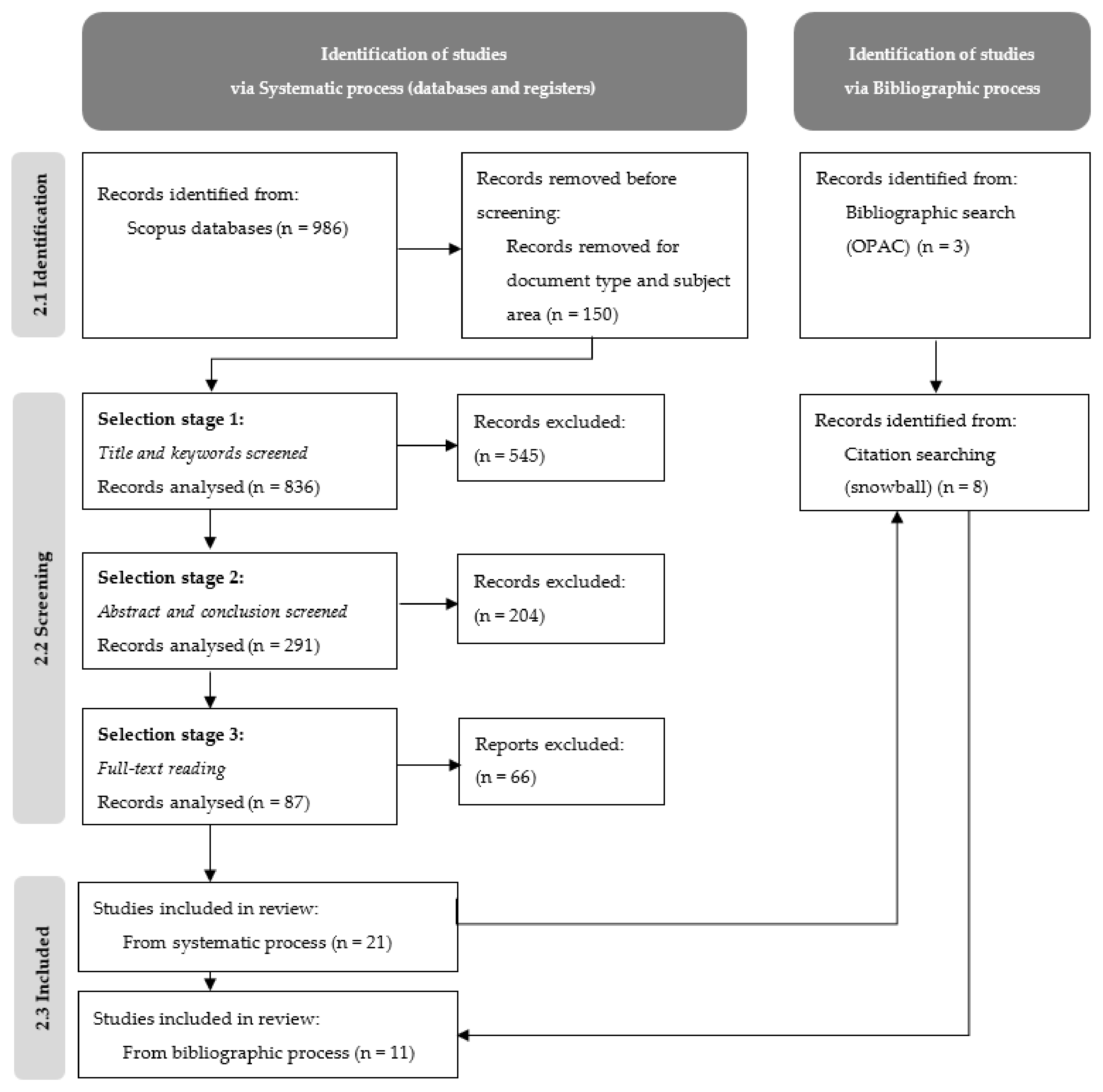
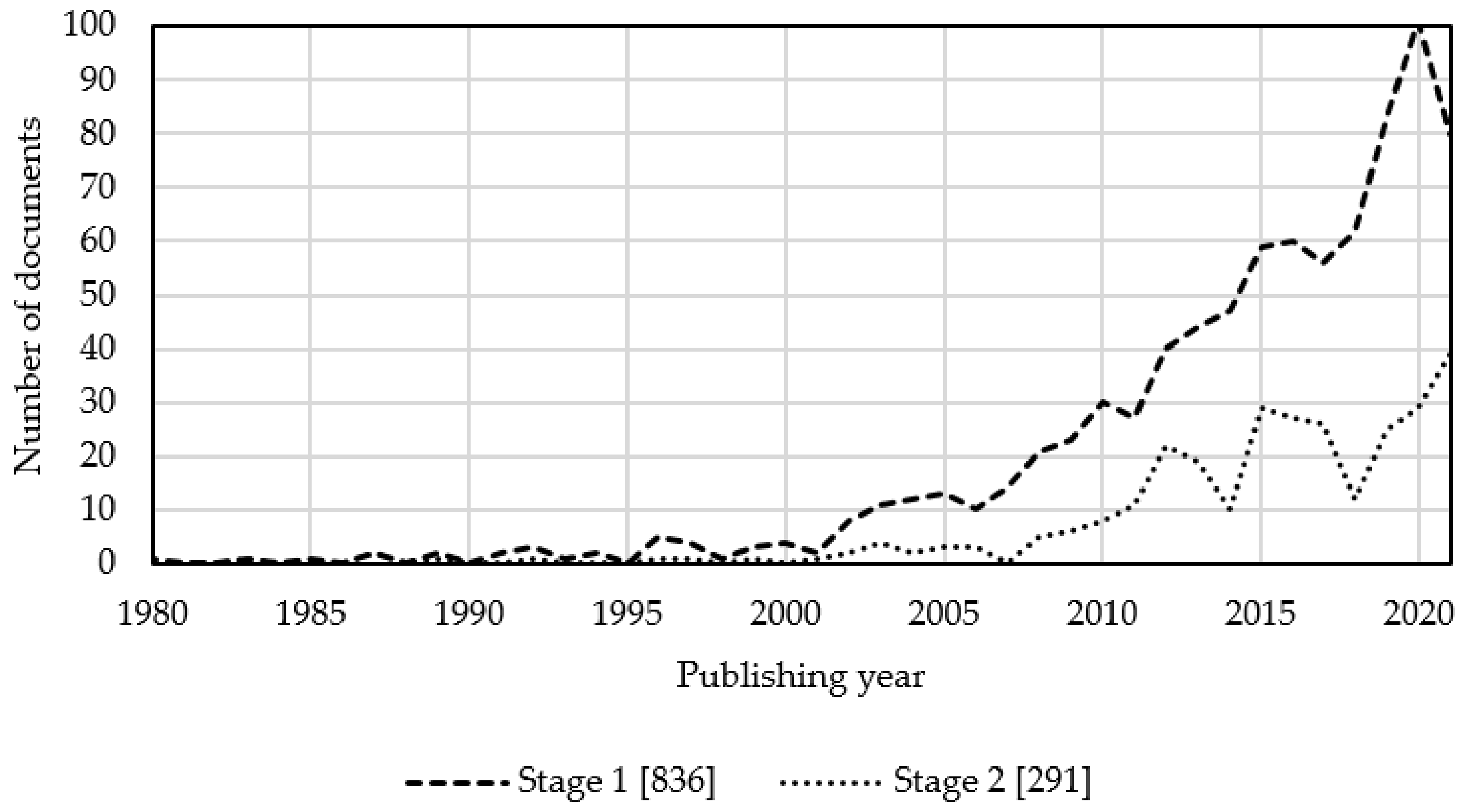
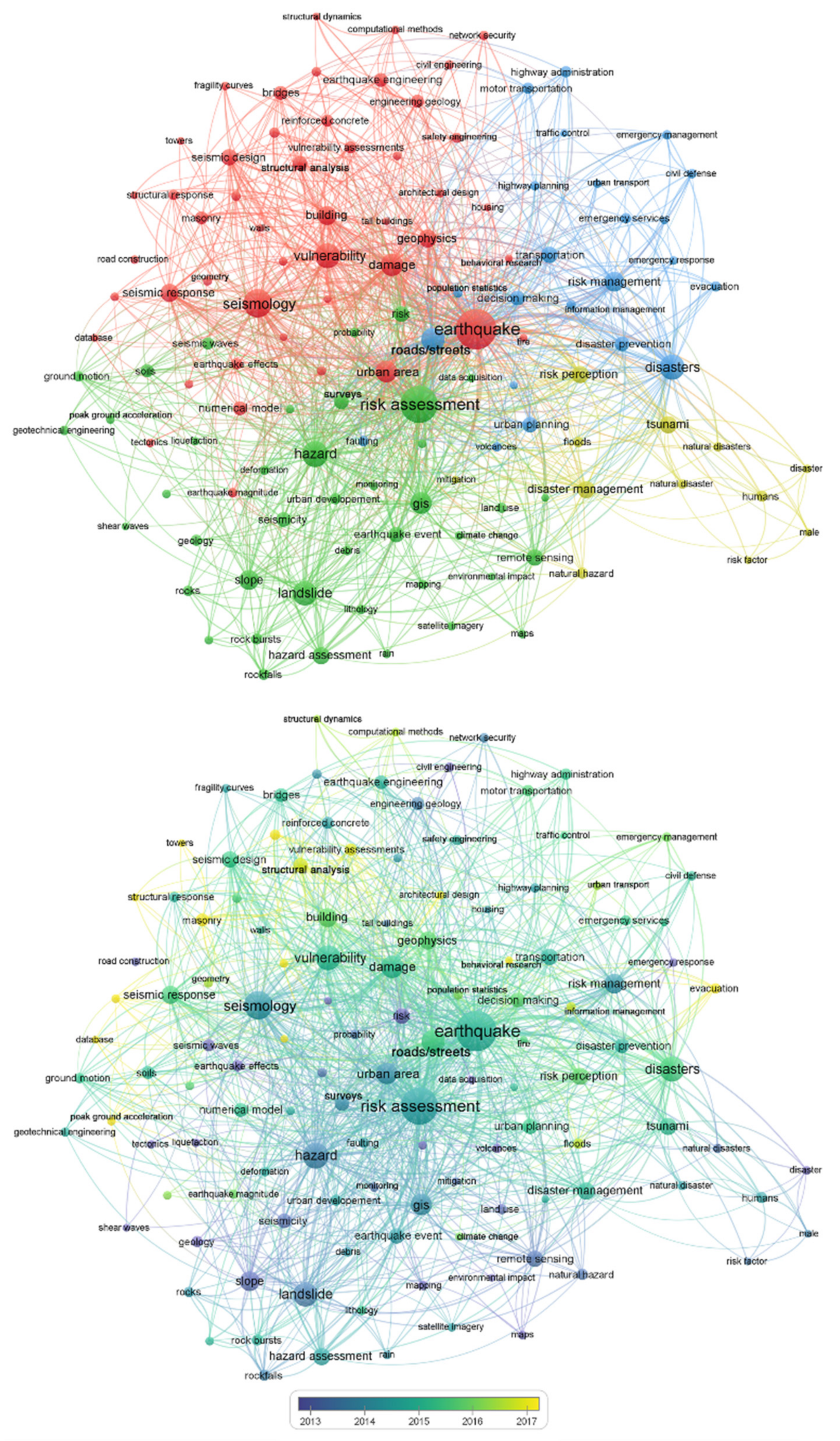
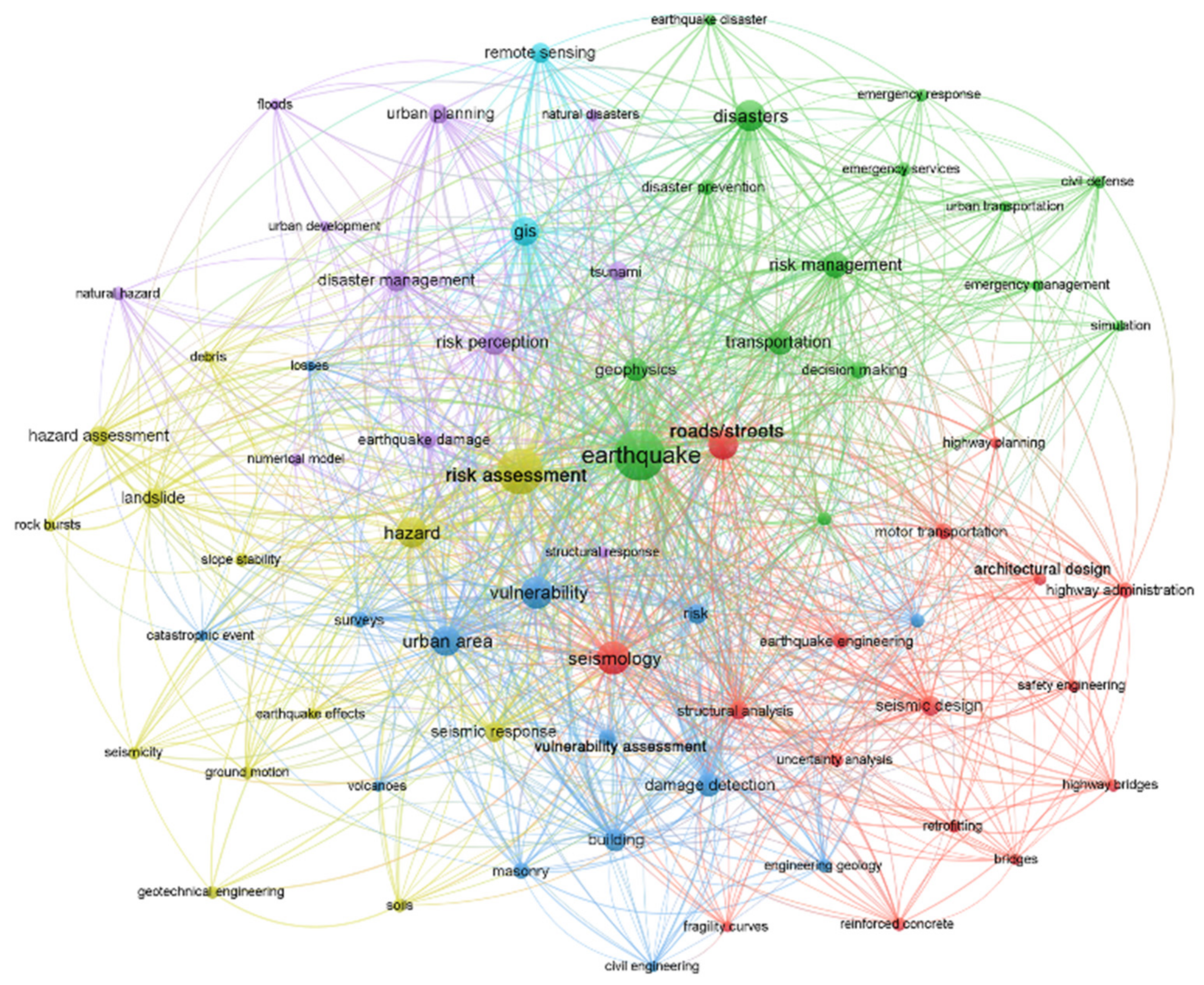
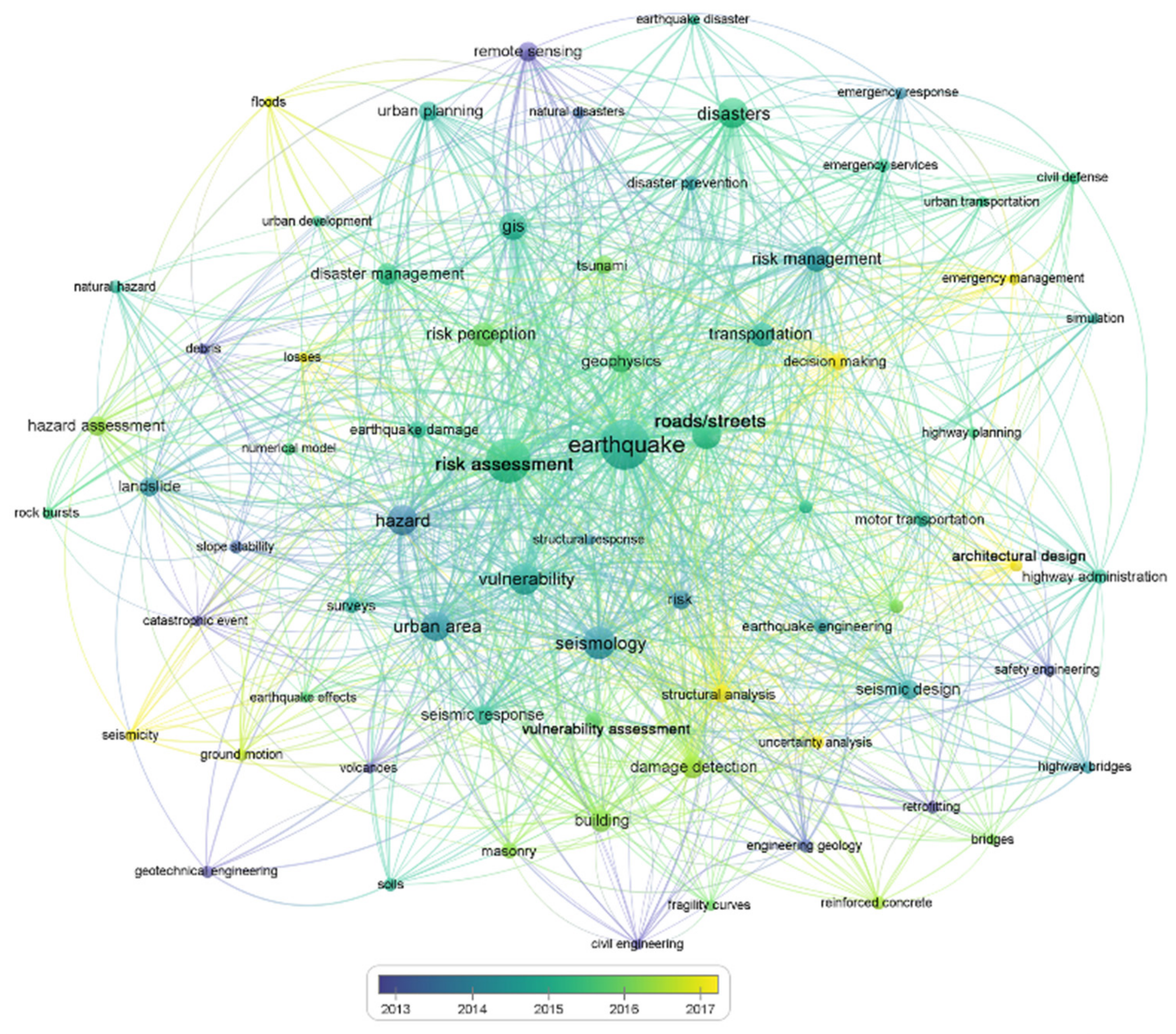

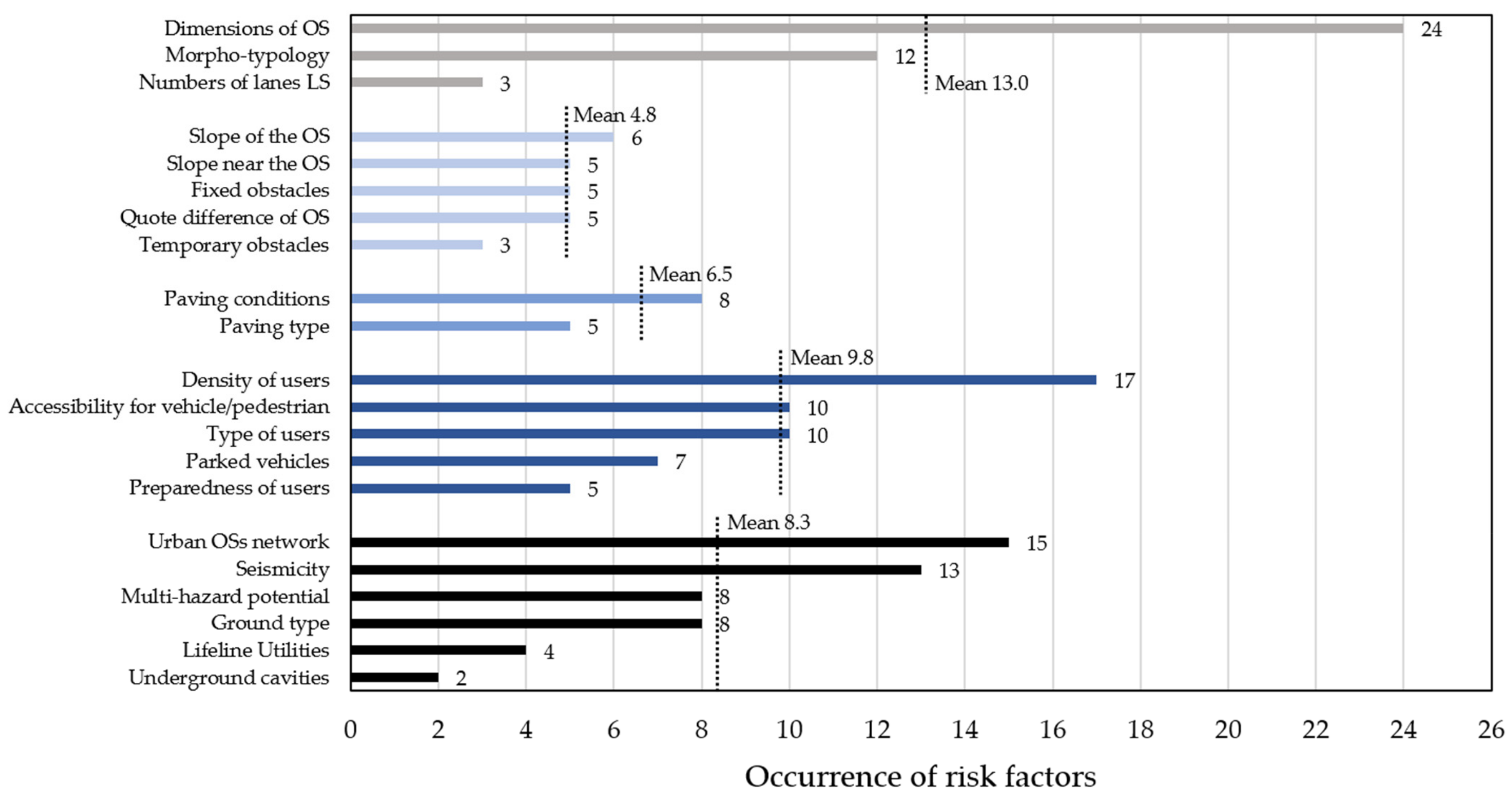

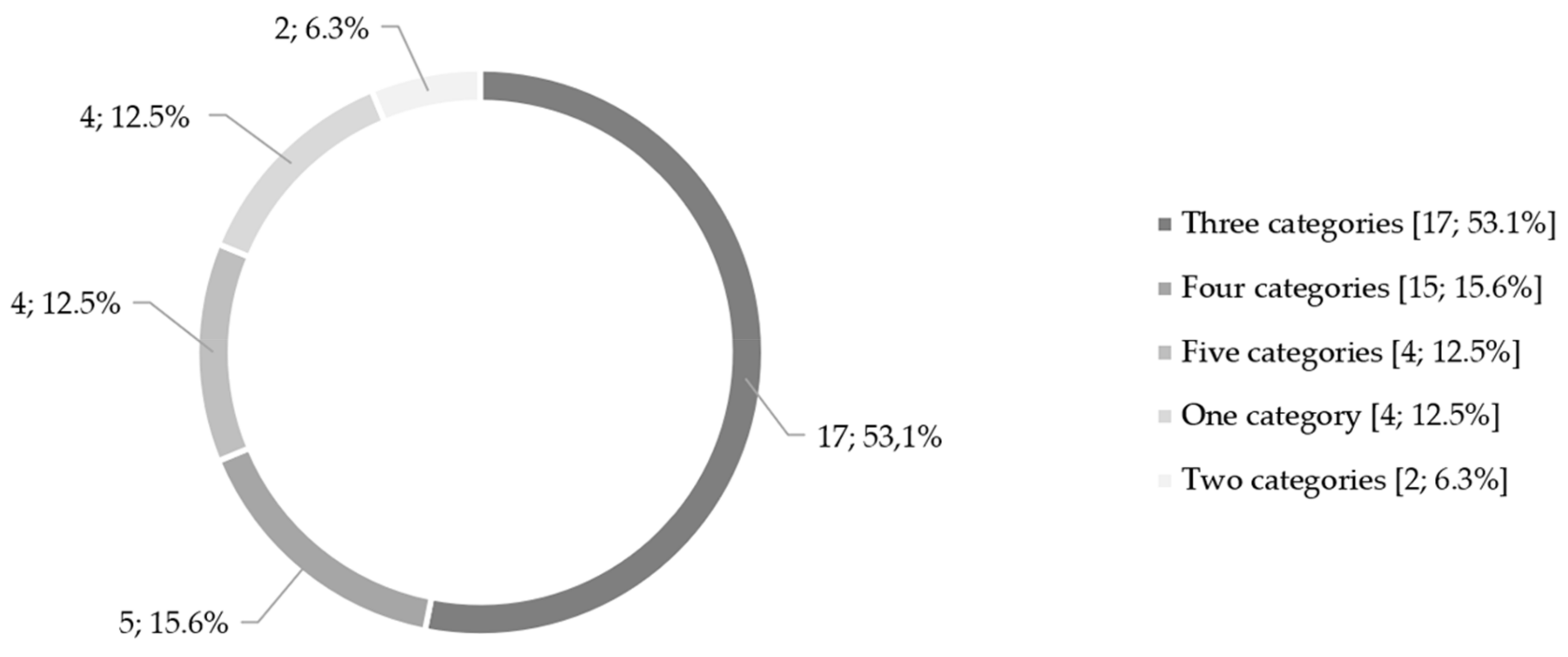
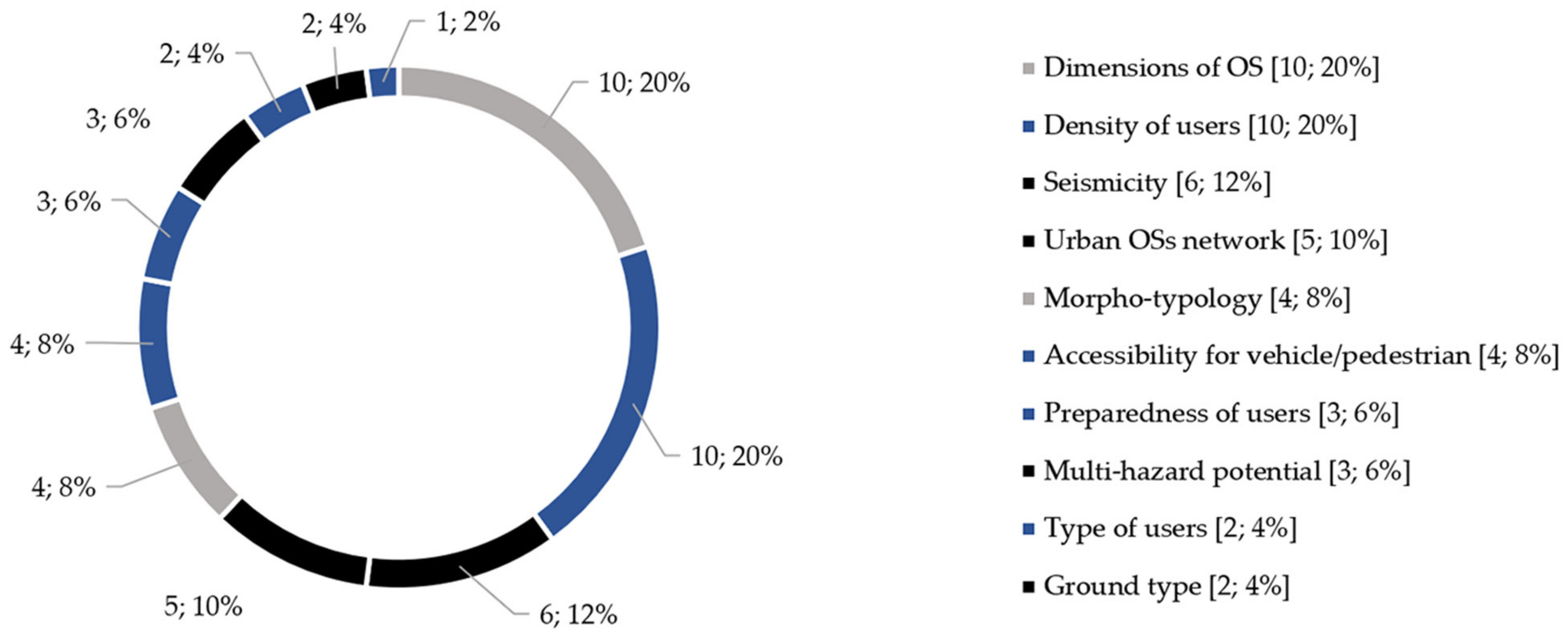

| Risk Factor | Disaster Type | Open Space | Data Characterization | ||
|---|---|---|---|---|---|
| Geometry and Space Characteristics | Constructive Characteristics | Use over Time and Space | |||
| Risk | Earthquake | Open space | Morphology | Construction technique | Pedestrian |
| Vulnerability | Seismic | Public space | Typology | Pavement | Vehicular |
| Urban area | Geometry | Obstacle | Evacuation | ||
| Road | Slope | Users | |||
| Square | Underground cavities | ||||
| Park | |||||
| Access | |||||
| Selection Stage | Actions | Eligibility Criteria |
|---|---|---|
| Stage 1 | Title and keywords evaluation | Keywords:
|
| Stage 2 | Abstract and conclusion evaluation | Objectives of research:
|
| Stage 3 | Full-text reading | Research results:
|
| Authors | Hazard 1 | Case Study | Identification Methods 2 | Type of Publishing Source 3 | ||||||
|---|---|---|---|---|---|---|---|---|---|---|
| Sy. | Sn. | Bi. | J. | C. | B. | G.L. | ||||
| [38] | Adafer and Bensaibi (2015) | Earthquake | Ain Temouchent, Algeria | X | X | |||||
| [39] | Álvarez et al. (2018) | Tsunami | Iquique, Chile | X | X | |||||
| [40] | Battegazzorre et al. (2021) | Earthquake | - | X | X | |||||
| [23] | Bernabei et al. (2021) | Earthquake | - | X | X | |||||
| [41] | Bernardini and Ferreira (2020) | Earthquake | Coimbra, Portugal | X | X | |||||
| [42] | Cremonini (2004) | Earthquake | - | X | X | |||||
| [9] | D’Andrea and Condorelli (2006) | Earthquake | Catania, Italy | X | X | |||||
| [43] | Der Sarkissian et al. (2020) | N.H. | Baalbek-Hermel Governorate, Lebanon | X | X | |||||
| [44] | Ertugay et al. (2016) | Earthquake | Thessaloniki, Greece | X | X | |||||
| [45] | Fazzio (2004) | Earthquake | Nocera Umbra, Italy | X | X | |||||
| [46] | Giuliani et al. (2020) | Earthquake | Lucignano, Italy | X | X | |||||
| [47] | Goretti and Sarli (2006) | Earthquake | Potenza, Italy | X | X | |||||
| [48] | Hajibabaee et al. (2014) | Earthquake | Tehran, Iran | X | X | |||||
| [49] | Ito et al. (2021) | Tsunami | Zihuatanejo, Guerrero, Mexico | X | X | |||||
| [50] | Kanno et al. (2016) | Earthquake | Shinjuku, Tokyo, Japan | X | X | |||||
| [51] | Kheliouen and Bouder (2020) | Earthquake | Boumerdés, Algiers | X | X | |||||
| [52] | Kumagai and Hatao (2013) | Earthquake | Neyagawa, Japan | X | X | |||||
| [53] | Lancioni et al. (2014) | Earthquake | - | X | X | |||||
| [54] | León and March (2014) | Tsunami | Talcahuano, Chile | X | X | |||||
| [55] | León et al. (2019) | Tsunami | Viña del Mar, Chile | X | X | |||||
| [24] | Lo et al. (2020) | Earthquake | Taipei City, Taiwan | X | X | |||||
| [29] | Quagliarini et al. (2018) | Earthquake | Offida, Italy | X | X | |||||
| [22] | Santarelli et al. (2018) | Earthquake | Civitanova Marche, Italy | X | X | |||||
| [56] | Sasabe et al. (2020) | Earthquake | Nagoya, Japan | X | X | |||||
| [57] | Tsionas et al. (2016) | Earthquake | Thessaloniki, Greece | X | X | |||||
| [12] | Tumini et al. (2017) | Tsunami | Mehuin and Dichato, Chile | X | X | |||||
| [58] | Utami and Nurhadi (2018) | Earthquake | Yogyakarta, Indonesia | X | X | |||||
| [59] | Wang and Jia (2021) | Tsunami | Seaside, Oregon, USA | X | X | |||||
| [60] | Wood et al. (2016) | Tsunami | Aberdeen, Hoquiam, and Cosmopolis, Washington, USA | X | X | |||||
| [61] | Yao et al. (2021) | Earthquake | Great Victoria, Canada | X | X | |||||
| [62] | Zhang et al. (2015) | N.H. | Beijing, China | X | X | |||||
| [63] | Zlateski et al. (2020) | Earthquake | Coimbra, Portugal | X | X | |||||
| Factor | Index | Definition | |
|---|---|---|---|
| Morpho-typology | [12] | Balance | Ratio between the overall surface of the unbuilt useful ASs and the overall surface of the built areas |
| [55] | Pedestrian route directness | Ratio between a route’s actual distance throughout urban space and the geodetic (or straight-line) distance between its origin and destination | |
| [62] | Road resistor coefficient | Ratio between the road length and the road width | |
| [41] | Tortuosity | difference between the minimum linear path length and the average evacuees’ path length | |
| [63] | Difference-in-path ratio | Ratio between the effective evacuation path length and the ideal one | |
| Dimension of the OSs | [12] | Temporary secure OSs | Ratio between the overall surface of the temporary secure ASs and the number of inhabitants in the same area |
| Evacuation route distances | Distance of evacuation routes from the farthest point in Euclidean distance | ||
| [63] | Effective areas surface | Difference between the OS area and the area occupied by debris |
| Factor | Index | Definition | |
|---|---|---|---|
| Temporary obstacles | [39] | Friction rate | Impact of the micro-vulnerabilities along the evacuation path on the evacuation speed |
| Factor | Index | Definition | |
|---|---|---|---|
| Accessibility for vehicles/pedestrians | [12] | Walkability | Ratio between the pedestrian walkway length and the total street length |
| [54] | Pedestrian speed conservation | percentage of evacuees’ speed loss | |
| Type of users | [59] | Walking speed variability | Adjustment in the walking speed due to age and physical condition |
| Density of users | [23] | Daytime, night-time, holiday time exposure | Evaluated as the sum of exposure for the outdoor and indoor areas for different times (daytime, night, holiday) |
| [12,48] | Population density | Ratio between the total inhabitant and the urban area | |
| [50] | Congestion degree | calculation of the crowding condition along evacuation paths | |
| [63] | Occupancy | Calculation of the crowding condition in the OS, considering the area reduction due to debris |
| Factor | Index | Definition | |
|---|---|---|---|
| Urban OSs network | [43] | Flow robustness | Ratio between the number of available flow and the total number of the possible flow in the network |
| [46] | Mean connectivity | Ratio between the connectivity values and the total number of segments | |
| Frequency | Ratio between the maximum actual choice in the set of segments and the maximum value it could virtually reach | ||
| [12] | Evacuation route | between the number of evacuation paths and the overall inhabitants | |
| [50] | Congestion degree | Calculation of the crowd along evacuation paths | |
| [55] | Connectivity | Ratio between street links and street nodes |
| Category | (1) Morpho-typological | (2) Physical | (3) Constructive | (4) Uses and Users | (5) Context |
| Weight | 31.4% | 4.9% | 2.8% | 19.3% | 41.5% |
Publisher’s Note: MDPI stays neutral with regard to jurisdictional claims in published maps and institutional affiliations. |
© 2021 by the authors. Licensee MDPI, Basel, Switzerland. This article is an open access article distributed under the terms and conditions of the Creative Commons Attribution (CC BY) license (https://creativecommons.org/licenses/by/4.0/).
Share and Cite
Russo, M.; Angelosanti, M.; Bernardini, G.; Severi, L.; Quagliarini, E.; Currà, E. Factors Influencing the Intrinsic Seismic Risk of Open Spaces in Existing Built Environments: A Systematic Review. Sustainability 2022, 14, 42. https://doi.org/10.3390/su14010042
Russo M, Angelosanti M, Bernardini G, Severi L, Quagliarini E, Currà E. Factors Influencing the Intrinsic Seismic Risk of Open Spaces in Existing Built Environments: A Systematic Review. Sustainability. 2022; 14(1):42. https://doi.org/10.3390/su14010042
Chicago/Turabian StyleRusso, Martina, Marco Angelosanti, Gabriele Bernardini, Laura Severi, Enrico Quagliarini, and Edoardo Currà. 2022. "Factors Influencing the Intrinsic Seismic Risk of Open Spaces in Existing Built Environments: A Systematic Review" Sustainability 14, no. 1: 42. https://doi.org/10.3390/su14010042
APA StyleRusso, M., Angelosanti, M., Bernardini, G., Severi, L., Quagliarini, E., & Currà, E. (2022). Factors Influencing the Intrinsic Seismic Risk of Open Spaces in Existing Built Environments: A Systematic Review. Sustainability, 14(1), 42. https://doi.org/10.3390/su14010042







